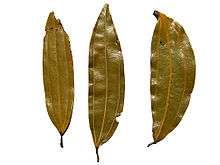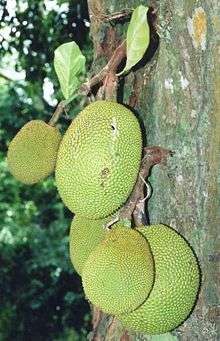Bay leaf


Bay leaf (plural bay leaves) refers to the aromatic leaves of several plants used in cooking. These include:
- Bay laurel (Laurus nobilis, Lauraceae). Fresh or dried bay leaves are used in cooking for their distinctive flavor and fragrance. The leaves should be removed from the cooked food before eating (see Safety section below). The leaves are often used to flavor soups, stews, braises and pâtés in Mediterranean cuisine. The fresh leaves are very mild and do not develop their full flavor until several weeks after picking and drying.[1]
- California bay leaf – the leaf of the California bay tree (Umbellularia californica, Lauraceae), also known as California laurel, Oregon myrtle, and pepperwood, is similar to the Mediterranean bay laurel, but has a stronger flavor.
- Indian bay leaf or malabathrum (Cinnamomum tamala, Lauraceae) is somewhat similar in appearance to the leaves of bay laurel, but is culinarily quite different, having a fragrance and taste similar to cinnamon (cassia) bark, but milder.
- Indonesian bay leaf or Indonesian laurel (salam leaf, Syzygium polyanthum, Myrtaceae) is not commonly found outside of Indonesia; this herb is applied to meat and, less often vegetables.[2]
- West Indian bay leaf, the leaf of the West Indian bay tree (Pimenta racemosa, Myrtaceae), used culinarily and to produce the cologne called bay rum.
- Mexican bay leaf (Litsea glaucescens, Lauraceae).
Chemical Constituents
The leaves contain about 1.3% essential oils (ol. lauri folii), consisting of 45% eucalyptol, 12% other terpenes, 8-12% terpinyl acetate, 3–4% sesquiterpenes, 3% methyleugenol, and other α- and β-pinenes, phellandrene, linalool, geraniol, and terpineol, contains lauric acid also.
Taste and aroma
If eaten whole, bay leaves (Laurus nobilis) are pungent and have a sharp, bitter taste. As with many spices and flavorings, the fragrance of the bay leaf is more noticeable than its taste. When dried, the fragrance is herbal, slightly floral, and somewhat similar to oregano and thyme. Myrcene, which is a component of many essential oils used in perfumery, can be extracted from the bay leaf. They also contain the essential oil eugenol.[3]
Uses
Bay leaves were used for flavoring by the ancient Greeks.[4] They are a fixture in the cooking of many European cuisines (particularly those of the Mediterranean), as well as in the Americas. They are used in soups, stews, meat, seafood, vegetable dishes, and sauces. The leaves also flavor many classic French dishes. The leaves are most often used whole (sometimes in a bouquet garni) and removed before serving (they can be abrasive in the digestive tract). Thai cuisine employs bay leaf (Thai name bai kra wan) in a few Arab-influenced dishes, notably massaman curry.[5]
In Indian and Pakistani cuisine, bay laurel leaves are sometimes used in place of Indian bay leaf, although they have a different flavor. They are most often used in rice dishes like biryani and as an ingredient in garam masala. Bay (laurel) leaves are frequently packaged as tejpatta (the Hindi term for Indian bay leaf), creating confusion between the two herbs.
In the Philippines, dried bay laurel leaves are added as a spice in the Filipino dish Adobo.
Bay leaves can also be crushed or ground before cooking. Crushed bay leaves impart more fragrance than whole leaves, but are more difficult to remove, and thus they are often used in a muslin bag or tea infuser. Ground bay laurel may be substituted for whole leaves, and does not need to be removed, but it is much stronger.
Bay leaves can also be used scattered in a pantry to repel meal moths,[6] flies, cockroaches, mice, and silverfish.
Bay leaves have been used in entomology as the active ingredient in killing jars. The crushed, fresh, young leaves are put into the jar under a layer of paper. The vapors they release kill insects slowly but effectively, and keep the specimens relaxed and easy to mount. The leaves discourage the growth of molds. They are not effective for killing large beetles and similar specimens, but insects that have been killed in a cyanide killing jar can be transferred to a laurel jar to await mounting.[7] It is not clear to what extent the effect is due to cyanide released by the crushed leaves, and to what extent other volatile products are responsible.
Safety
Some members of the laurel family, as well as the unrelated but visually similar mountain laurel and cherry laurel, have leaves that are poisonous to humans and livestock. While these plants are not sold anywhere for culinary use, their visual similarity to bay leaves has led to the oft-repeated belief that bay leaves should be removed from food after cooking because they are poisonous. This is not true – bay leaves may be eaten without toxic effect. However, they remain very stiff even after thorough cooking, and if swallowed whole or in large pieces, they may pose a risk of scratching the digestive tract or even causing choking. There are multiple cases of intestinal perforations caused by swallowing bay leaves, and they should not be swallowed or left in the food before serving to prevent the occurrence of a possibly fatal surgical emergency.[8][9] Thus, most recipes that use bay leaves will recommend their removal after the cooking process has finished.[10]
External links
References
- ↑ "Spice Trade: Bay Leaf". Archived from the original on 12 April 2009. Retrieved 2009-04-11.
- ↑ "Spice Pages: Indonesian Bay-Leaf". Retrieved 2012-12-01.
- ↑ "Encyclopedia of Spices: Bay Leaf". Retrieved 11 April 2009.
- ↑ "Ancient Egyptian Plants: Trees" www.reshafim.org.il Retrieved October 29, 2013
- ↑ Tan, Hugh T. W. (2005). Herbs & Spices of Thailand. Marshall Cavendish. p. 71.
- ↑ "How to Repel Grain Moths with Bay Leaves". Retrieved 2009-04-11.
- ↑ Smart, John (1963). British Museum (Natural History) Instructions for Collectors NO. 4A. Insects. London: Trustees of the British Museum.
- ↑ Lingenfelser, T; Adams, G; Solomons, D; Marks, I. N. (1992). "Bay leaf perforation of the small bowel in a patient with chronic calcific pancreatitis". Journal of Clinical Gastroenterology. 14 (2): 174–6. PMID 1556436.
- ↑ Bell, C. D.; Mustard, R. A. (1997). "Bay leaf perforation of Meckel's diverticulum". Canadian Journal of Surgery. 40 (2): 146–7. PMC 3952980
 . PMID 9126131.
. PMID 9126131. - ↑ "Straight Dope: Are Bay Leaves Poisonous?". Retrieved 2009-04-11.
